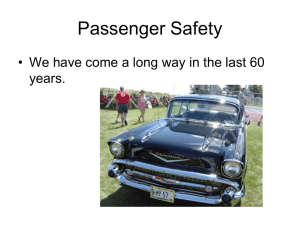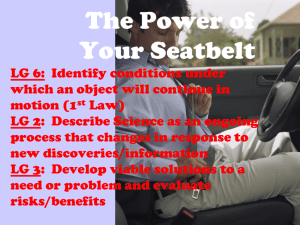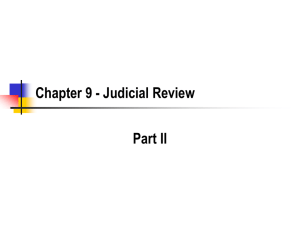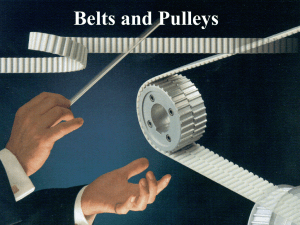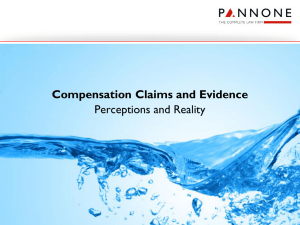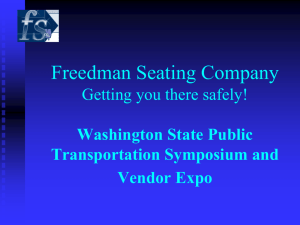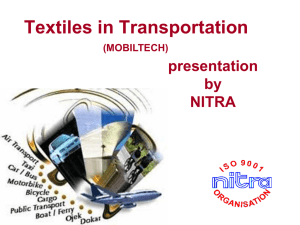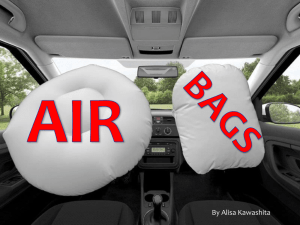Passenger Safety
advertisement
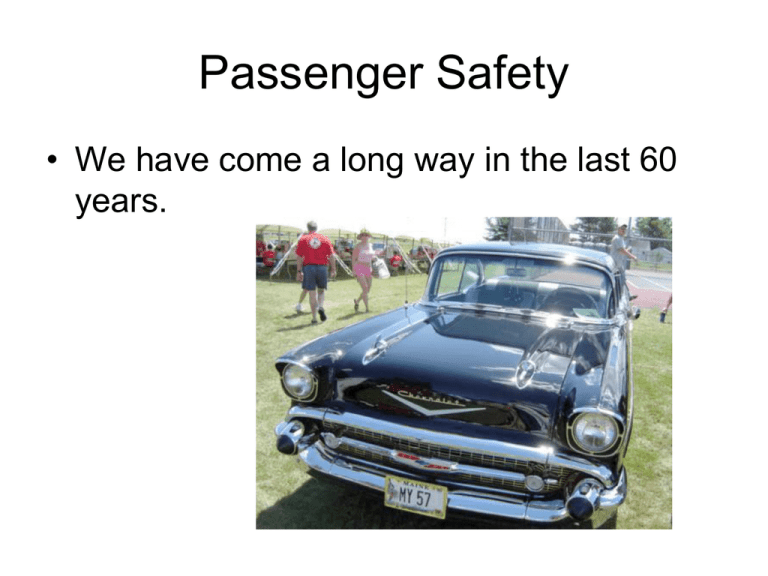
Passenger Safety • We have come a long way in the last 60 years. Four traditional accident prevention programs have been used for the last 100 years in an attempt to prevent traffic accidents and resulting injuries. • A. Driver licensing. The purpose of driver licensing is only allow competent drivers on the highways. This includes getting the worst drivers off the road. • B. Engineering. Engineering of both vehicles and highways to reduce the probability of an accident. • C. Enforcement of traffic laws. Compliance with traffic laws is in direct proportion to the perceived level of enforcement. Without enforcement of traffic laws, we would have chaos. • D. Education. Driver and traffic safety education attempts to reduce the number of accidents by education of beginning drivers, education of problem drivers as well as public service ads designed toward the general population. i.e. "friends don't let friends drive drunk" Loss Reduction • Loss reduction is an acceptance that we can not prevent all accidents from occurring. Therefore we must do what we can to reduce losses when accidents do take place specifically loss of life, injuries and property damage. The Costs • There are about 32,000 deaths, 2,000,000 serious injuries and $200 billion lost in traffic accidents each year in the US. • These numbers are on the safest road system in the world! Highway Engineering • There are numerous roadway designs to reduce losses when a vehicle leaves the roadway. Divided highways, guard rails, bridge design, bridge supports, removal of light poles, signs and trees next to the road, just to name a few. • All of these lessen the chance of crashing when leaving the roadway. Vehicle Design • There are many design features on vehicles over the past 40 years. Some of them are: seat belts for all passengers; shoulder harnesses; windshield design; head restraints; airbags; padded dash boards; door locks and recessed handles; seat anchors; side impact reinforcement; side air bags; adjustable gas and brake pedals; roof crush reinforcement; tempered side windows; fuel tank integrity; seat back locks for two door cars; collapsible steering columns; crush zone; and flame retardant seat materials. • The vehicle today is the safest to crash ever built. Where to look www.highwaysafety.org This website has vehicle safety ratings if you are interested. Baby with the bathwater? • Accident prevention is also a continuing design feature. These features include: high mounted brake lights; antilock brakes; dual brake systems; standard operational controls; ergonomic seats/controls; daytime running lights; even seat belts help the driver maintains control of the vehicle in an emergency. SCS. • Stability Control Systems actually take over control of your vehicle if you over react to any situation. You no longer have a cable to your accelerator, and your braking and steering are also computer controlled, hope is does not short out! • 1996 and newer cars have a computer that can tell officers what you were doing prior to the collision. OnBoard Diagnostic. At Least Six Reasons to Wear Your Belt. • A. Prevent ejection from the vehicle. A driver/passenger is 25 times more likely to die outside the vehicle in a crash. • B. Lessen the collision with the interior of the vehicle. What you hit, where you hit it, and how hard you hit it. • C. Provide better protection in fire or water. Belts keep your head from hitting the wheel or dash and being knocked unconscious. Awake you can get yourself out of water or a burning car. • D. Better control of the vehicle in an emergency. If you are not behind the wheel, you cannot drive. If you are struggling to stay behind the wheel, you cannot drive well. • E. Air bags present a threat to life if you are too close to them. Seat belts help keep you in position to allow the air bags to work as designed, not kill you. • F. It's the law. About 90% of North Carolina drivers now wear the seat belts. That number is about 85% in the US. Why seat belt laws? • Seat belt usage at 85% nationally (up from 14% twenty years ago) is estimated to save 12,000 lives a year, and save about $17 billion. Thrown out? • Your chances of being killed are 25 times greater outside the vehicle. • We have spent fifty years designing safer vehicles. Stay in them. Child Restraints • Thirty-five years ago, only 4% of children were properly restrained. With laws requiring child restraint use in all US jurisdictions, the percent of children restrained is 85%+. • A major problem with child restraints continues to be the improper use of them. Improper use can compromise safety. • Remember, traffic is the most dangerous place these children will ever be. NC Child Restraint Law • In NC all children under 16 must be restrained. • Those under 5 years old (or 40 lbs) must be in a DOT approved child restraint. • Those under 8 years and 80lbs, must be in a booster seat. The penalty is $25 plus court costs (about $136). • There are two driver license points assigned for violation. • The child restraint law is primary enforcement. This means an officer can stop someone for a violation of this law without any other traffic violation necessary. Click it or Ticket • The belt use rate in NC is 90%+. In the US it is closer to 85%. • NC is among the highest use rates of the 50 states. "Click it or ticket" is one reason. Front Seat Law • This law states that all front seat occupants must be properly restrained. • This is regardless of age. The fine is $25 and now $50 in court costs are added. • There are no points attached to this seat belt use law in NC. New Law, 12/06 • As of December of 2006, rear seat occupants must wear there belts as well. • The problem with this law is it has no teeth. The fine is $10 for the second offense. • The good news is that the first step is done. The penalties will increase over time, just as the child restraint law has developed. Why all the fuss? I am the only one affected buy not wearing a belt • The people who are injured because they refused to wear a restraint, cost us all in many ways. • Here are some of the INDIRECT COSTS of people who are injured because the seat belt was too much trouble. Insurance • Insurance rates are determined by costs to the companies. The more they pay out, the more cost is passed to future policy holders. • Insurance companies do NOT pay claims, policy holders do. Court Costs • If you have ever been to district or superior court and watched the wheels of justice turn, you would have to agree that the wheels of justice turn slowly if at all. • How many trial lawyers have made their fortune in court, over an injury that could have and should have been prevented by a belt? • Remember, you pay for all the court personnel, the building etc. All paid for with your taxes. Social Security • How many think you will ever see a check from Social Security? Sorry. • If a person is killed or injured in a crash, (that should not have) how does that affect SS? Instead of paying 15% of his/her paycheck into the system, now they may just get a disability check FROM the system. • Who pays that? Right again, YOU DO. Education Wasted • In NC, the tax payers fund your education to the tune of about $6,500 per year for 13 years. • When you come to EC, we (tax payers) fund you again to the tune of about $9,000 per year. • That is well over $120,000 per child invested. You kill yourself because a seat belt is too much trouble to put on, and we just wasted our investment. EMT • How many hours are wasted by emergency personnel treating persons injured when they should not have been. • BTW. Ever waited for an ambulance? Why was is delayed? Was is at the at someone else’s injury accident? • Get the point? Medical Availability • If you have ever waited to get into a hospital, PCMH is full. They also have to keep beds available for “trauma” victims. That’s car crashes. • Blood supply is another. You will have to wait for “elective” surgery. Got to keep the blood available too. Time off work • How many work days are missed because of injuries that should/could have been prevented. • We loose 500,000 man/years of labor every year to car accidents. • How many could have been prevented? Police Services • How many man hours of police personnel are used to deal with accidents and injuries that could/should have been prevented? Medical Costs • Did you know that 40% of your hospital bill is to pay for the guy next to you that does not have insurance? • We must, by law, treat them. Well PCMH is not going to pay for them, you will. • A higher percentage of the uninsured, don’t wear belts either. • Again, we all pay. Serious Injuries • Each year, in the US, there are 600,000 neck/spinal cord injuries, 179,000 brain injuries and 638,000 facial injuries. Seat belts with air bags can prevent a significant percentage of these. • A neck/spinal cord injury takes 200 health care professionals and a $1Million to treat. Let’s look at Airbags • First the Bad. • A. Cost about $1,000 per vehicle. B. Cost about $2,000 to reinstall them C. They only work in front end, front angular collisions. (about 50% of all collisions). D. Minor burns and injuries. E. Noise and "gas" in vehicle when deployed. F. Deaths -(Later) The Good • A. They work. The mechanics are not a significant problem. B. They are a passive system. It takes no action on the part of the passengers to allow it to work. (Remember it always works best with the active restraint-seatbelt). C. They work best in the most serious type of accident-head-on and front angular collisions. Suggestions for Improvement of Airbags • The suggestions for improving their effectiveness are: A. Slow them down to 160 MPH B. Allow for ignition shut off switches for children who have to use the front seat. C. "Smart" airbags to determine the size and location of passengers D. Pedal and steering columns adjustments for short people to get away from the air bag E. Education to get children in the back seat away from the airbag. Airbags is Vehicles • Airbags have been required in cars, driver’s side, since 1993. • SUVs and trucks, about 1996. • So for over 10 years, all vehicles have front airbags. • Millions are deployed each year, with 6 million accidents each year. • You are looking at 10s of millions of vehicles with airbags. Where to find information • www.highwaysafety.org • Great resource for any traffic safety issue. Airbags save lives • 1000’s of lives are saved every year by airbags. • Misuse by a few is no reason to consider turning them off or removing them.\ • Second only to seat belts in saving lives. How good? • Airbags add about 25% to seat belts. • Seat belts reduce death or serious injury by 50-60%. • Add 25% to that, we are near 80% of deaths and/or serious injuries can be prevented. • Buy a car with airbags, wear your belt! What about Side Impact Airbags? • The information about side impact airbags is slowly becoming available. They are still in the development phase. • The fact remains that of the 24,000 vehicle occupants killed each year in the US, nearly 8,000 of them are side impact collisions. • More needs to be done to reinforce and pad the sides of vehicles to protect occupants. • The side “curtain” airbags is showing promise in preventing head injuries. At no extra charge… • Want to know what sells cars today? • Safety and Performance. • A true oxymoron. Conclusion • The vehicles we have today are the easiest to drive, safest to crash we have ever had. • That is why the total deaths is only 32,000. • Slow down. Buckle up. Drive sober.
